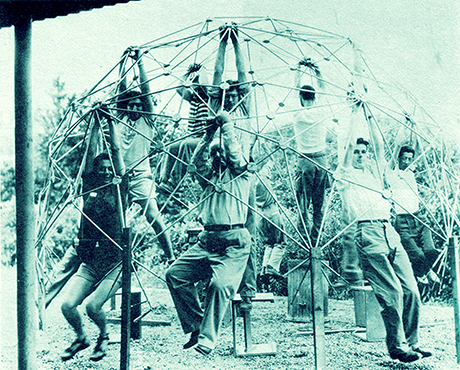Book Launch, Performance, and Panel /
“The Experimenters: Chance and Design at Black Mountain College,” with Eva Díaz, Nick Hallett, Judith Rodenbeck, and Jeremy Sigler
Date: Thursday, 12 February 2015, 7–9 pm
Location: Cabinet, 300 Nevins Street, Brooklyn (map and directions here)
FREE. No RSVP necessary

Please join us to celebrate the publication of Eva Díaz’s new book The Experimenters: Chance and Design at Black Mountain College (University of Chicago Press). The evening will include a discussion between Díaz and art historian Judith Rodenbeck; performances by musician Nick Hallett and poet Jeremy Sigler; and a screening of a rare Black Mountain College work by Xanti Schawinsky.
Everyone in the art world today loves to invoke “experimentation,” but more than at any other time and place, it was an unaccredited school in rural Appalachia in the years following World War II that generated radical new art forms and triggered heated arguments about what an experimental practice could be. Practically every major artistic figure of the mid-twentieth century spent some time at Black Mountain College: Merce Cunningham, Ray Johnson, Franz Kline, Willem and Elaine de Kooning, Robert Motherwell, Robert Rauschenberg, Dorothea Rockburne, Aaron Siskind, Cy Twombly—the list is long. Yet many have tended to view these artists’ time at Black Mountain as little more than a prologue, a step on their way to greatness. In The Experimenters, Díaz reveals the importance of Black Mountain College—and especially of three key teachers, Josef Albers, John Cage, and R. Buckminster Fuller—to be much greater than that.
Díaz’s focus is on experimentation. Albers, Cage, and Fuller, she shows, taught new models of art making that favored testing procedures rather than personal expression. These methodologies represented incipient directions for postwar art practice, elements of which would be sampled, and often wholly adopted, by Black Mountain students and subsequent practitioners. The resulting works, which interrelate art and life in a way that imbues these projects with crucial relevance, not only reconfigured the relationships among chance, order, and design—they helped redefine what artistic practice was, and could be, for future generations.
The occasion of the launch of Díaz’s book provides the opportunity for a conversation and a series of performances about the risks and possibilities of using the concept of the “test” as a lens to produce, teach, and understand art. Please come and take part in this test!
Copies of The Experimenters will be available for purchase.
About the Participants
Eva Díaz is assistant professor in the History of Art and Design Department at Pratt Institute in Brooklyn. Her next book will be The Fuller Effect: The Critique of Total Design in Postwar Art about the legacy of Buckminster Fuller in postwar and contemporary art, for which she received an art writer’s grant from Creative Capital/Warhol Foundation. Her writings have appeared in magazines and journals such as The Art Bulletin, Artforum, Art Journal, Art in America, Cabinet, Frieze, Grey Room, October, and Tate Etc., and in numerous museum exhibition catalogues.
Nick Hallett is a composer, performer, and cultural producer. Whispering Pines 10, an opera collaboration with artist Shana Moulton, has been staged at the Kitchen, the New Museum of Contemporary Art, SFMOMA, the Warhol Museum, and Portland Institute of Contemporary Art’s TBA Festival. He is the music director and producer of the Joshua Light Show—a team of live cinema artists with roots in the 1960s psychedelia movement—which appears worldwide, and more recently has performed to Hallett’s original sound scores at the American Museum of Natural History’s Hayden Planetarium and at the Papalote Digital Dome in Mexico City as part of the MUTEK festival. He has staged a diverse body of work in New York and abroad, from rarely heard compositions of experimental music at Issue Project Room (as co-director of the Darmstadt series) to a wide range of performance at the Kitchen to his own media rituals of music and light, always involving the human voice, at the New Museum of Contemporary Art and PERFORMA, among others. He is currently composing the music for choreographer Bill T. Jones. As a vocalist, Hallett has performed music by Anthony Braxton, Susie Ibarra, and Meredith Monk, among others.
Judith Rodenbeck received her Ph.D. in art history from Columbia University in 2003 and is a professor in the Media and Cultural Studies Department at University of California, Riverside, after fourteen years on the faculty at Sarah Lawrence College. Her first book Radical Prototypes: Allan Kaprow and the Invention of Happenings (MIT Press, 2011) explores the emergence of performance and intermedia in the American fine arts of the 1950s. In addition to authoring numerous catalogue essays, she has served as editor-in-chief of the Art Journal and is on the editorial board of Evental Aesthetics. Her work has appeared in journals such as October, Grey Room, X-TRA, Artforum, Modern Painters, Sculpture, Woman’s Art Journal, and Camera Austria, among others. Her teaching and research interests encompass critical theory, performance studies, the politics of aesthetics, and radical pedagogy, especially as these engage with modernism and its avant-gardes and with contemporary artistic practice. A Fellow at the Clark Art Institute in the fall of 2013, she is also a past recipient of grants from Creative Capital/Warhol Foundation, the Mellon Foundation and the American Council of Learned Societies.
Jeremy Sigler is the author of numerous books of poetry including To and To (Left Hand Books, 1998); Mallet Eyes (Left Hand Books, 2000); Crackpot Poet (Black Square Editions, 2010); and ABCDEFGHIJKLMNOPQRSTUVWXYZ (The Kingsboro Press and For The Common Good, 2014). Sigler has taught sculpture in numerous graduate art programs, worked as the New York senior editor of Parkett, and was formerly the Manager of Publications at Dia Art Foundation in New York. Sigler co-edited the career retrospective monograph Carl Andre: Sculpture as Place, 1958–2010 (Dia Art Foundation and Yale University Press, 2014).

Beer for this event has been lovingly provided by Brooklyn Brewery. Refreshments courtesy of Sprizz-O.
